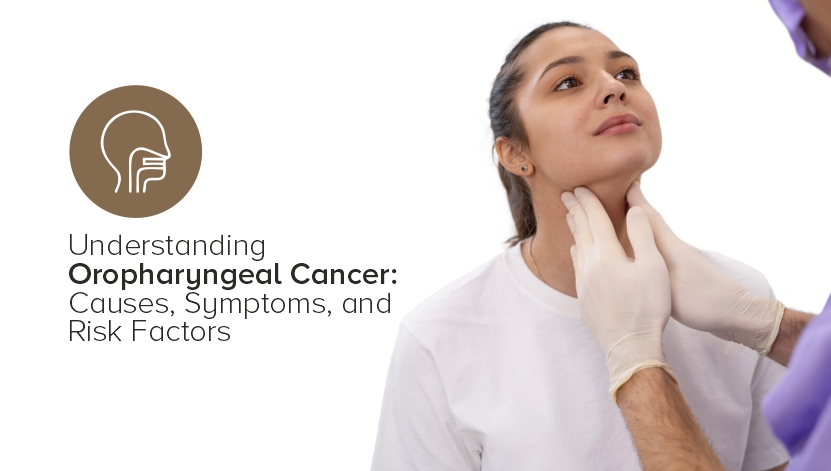Cancer of the oropharynx, a part of the pharynx (throat) located at the back of the mouth including the soft palate, tonsils, and base of the tongue, is a serious health concern that has been steadily increasing in incidence over the past few decades. With a rising number of diagnosed cases, there's no doubt that understanding oropharyngeal cancer, its causes, and its associated risk factors is crucial in both prevention and management.

Oropharyngeal cancer, often referred to as throat cancer, typically begins in the flat, squamous cells that line the oropharynx. It can develop in any part of the oropharynx but is most common in the tonsils and at the base of the tongue.
There are several types of oropharyngeal cancer, including:
Squamous Cell Carcinoma: This is the most common type of oropharyngeal cancer that occurs in the flat cells lining the oropharynx.
Adenocarcinoma: These cancers form in the glandular cells of the oropharynx and are relatively rare.
Sarcomas: These cancers develop in the muscles, cartilage, fibrous tissues, blood vessels, or other connective or supportive tissues.
Lymphomas: These cancers start in the immune system, particularly in the lymph nodes or other lymph tissues.
Oropharyngeal cancer is a significant public health issue across the globe. The incidence of oropharyngeal cancer varies widely depending on geographic location, with certain regions being more heavily affected. These differences can be attributed to lifestyle factors, such as tobacco and alcohol use, as well as to the prevalence of certain infections, particularly human papillomavirus (HPV).
Diagnosis of oropharyngeal cancer involves a thorough physical examination, as well as various imaging tests and biopsies. Staging is crucial as it dictates the treatment plan. The TNM classification system categorizes the extent of the primary tumor (T), whether cancer has spread to nearby lymph nodes (N), and whether it has metastasized (M).
Understanding the underlying causes of oropharyngeal cancer is vital in taking preventive measures. Several factors have been identified that increase the risk of developing this type of cancer.
Use of any form of tobacco, including cigarettes, cigars, pipes, and smokeless tobacco, significantly increases the risk of oropharyngeal cancer. This risk can compound with the duration and quantity of tobacco use.
Regular and heavy alcohol consumption is also a well-established risk factor for oropharyngeal cancer. The risk increases with the amount and duration of alcohol consumption.
HPV, particularly the strains 16 and 18, has emerged as a significant risk factor for oropharyngeal cancer in recent years.
A diet low in fruits and vegetables, which are rich in antioxidants, may increase the risk of cancer in the oropharynx. Certain dietary factors, such as the use of betel quid, a mixture of areca nut, tobacco, and other ingredients, can also elevate the risk.
Exposure to certain workplace environments, such as wood dust or nickel fumes, has been linked to an increased risk of oropharyngeal cancer.
Early detection of oropharyngeal cancer is associated with better treatment outcomes. Recognizing the potential signs and symptoms is a key component to this.
The common symptoms of oropharyngeal cancer include:
Routine screening for oropharyngeal cancer is not conducted in the general population. However, for individuals with specific risk factors, regular screenings may be recommended, particularly those with a history of smoking, alcohol abuse, or HPV infection.
Regular self-examination using a mirror to look at the back of the throat can aid in the early detection of oropharyngeal cancer. Any unusual growth, lump, or sore that does not resolve within two weeks should be evaluated by a healthcare professional.
Several risk factors for oropharyngeal cancer can be modified, which makes prevention a possibility.
Quitting smoking and other forms of tobacco use significantly reduce the risk of developing oropharyngeal cancer. The benefits of quitting can be seen as early as 20 minutes after the last cigarette.
Reducing or eliminating alcohol consumption, particularly heavy drinking, can lower the risk of oropharyngeal cancer. Abstinence may be recommended for individuals with other risk factors.
Vaccines are available to protect against the high-risk strains of HPV. These vaccines have been shown to be effective in preventing oropharyngeal cancer, among other HPV-associated cancers.
A healthy diet rich in fruits and vegetables can contribute to a lower risk of cancer. Avoiding the use of betel quid and other known carcinogens can also help prevent the disease.
The treatment of oropharyngeal cancer depends on the stage of the disease and the patient's overall health.
Surgery may be performed to remove the cancerous tumor, typically followed by radiation therapy or chemotherapy to destroy any remaining cancer cells.
Radiation therapy uses high-energy X-rays to kill cancer cells. It may be used alone or in conjunction with surgery or chemotherapy.
Chemotherapy involves the use of drugs to kill cancer cells. It is often used in advanced oropharyngeal cancer, either alone or in combination with radiation therapy.
Targeted therapy uses drugs that attack specific abnormalities within cancer cells. It is a newer approach to treatment with less impact on normal, healthy cells.
Oropharyngeal cancer is a complex disease with a variety of risk factors. While certain factors, such as HPV infection and genetic predisposition, cannot be controlled, many other influential elements, like tobacco and alcohol use, are modifiable. Prioritizing lifestyle choices, monitoring symptoms, and seeking early intervention are all essential in the fight against oropharyngeal cancer. For comprehensive head and neck cancer treatment in India, American Oncology Institute is recognized as the top multi-disciplinary oncology hospital known for its expertise and advanced care.